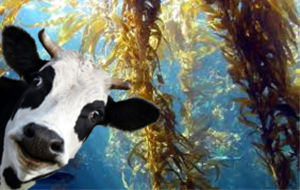
In a world riddled with complexity, simple solutions to problems like climate change are hard to come by, which makes the stories of sea otters, cows and seaweed all the more intriguing – and encouraging.
Sea Otters and Kelp
Warming ocean water have upset coastal ecosystems. Off the cold, rocky coast of Santa Cruz, California, giant kelp forests have been devastated by swarms of urchins, which thrived after warmer water killed off schools of starfish, the predator that kept the urchin population in balance.
Eventually, the unrestrained urchins ate themselves out of house of home and began to languish. Experts say urchins can go years without eating, becoming in effect water zombies. Meanwhile, the once bountiful kelp forests in a 60-mile stretch from Point Arena to Bodega Bay declined by 95 percent, harming local urchin fisheries, denying gray whales a forest sanctuary from orcas and preventing sequestration of carbon emissions at rates far greater than land forests.
Kelp forests are some of the most productive habitats on Earth, according to Meredith McPherson, who authored a study about the demise of the Northern California kelp forest. They also are naturally resilient, except when normal marine water heat fluctuations are intensified by more fundamental ecological changes.
The research goes further than doom and gloom, noting an unsuspecting success story in Monterey Bay where sea otters have protected patches of the kelp forest by eating urchins and maintaining a natural ecological balance. The kelp is barren in the rest of the bay where otters don’t patrol. Otters haven’t widened their hunting zone because the zombie urchins are nutritionally worth the bother.
The multi-species story of the kelp forest, urchins, starfish and sea otters is a cautionary tale of climate change. Normal fluctuations can become killing fields by tipping-point shifts in temperature. The cascading effects of ecological change can, and often do, make the underlying cause of abnormal changes worse or permanent – greenhouse gas emissions are linked to higher temperatures, melting glaciers and warm ocean water, which in turn can lead to the destruction of natural mechanisms such as kelp that sequester huge amounts of carbon in the atmosphere.
The patches of kelp forest in Monterrey Bay protected by sea otters display its potential resilience to regenerate. Because kelp doesn’t have GPS tracking capability, it will take a helping hand for humans to restore kelp beds by finding other areas where sea otters and starfish exist or could exist. The idea is to create “kelp oases”.
Seaweed and Cows
There are 1.5 billion cows on the planet and they burp methane, lots of methane, roughly the equivalent of the emissions from 650 million cars. The problem is so severe, many ecologists are urging a switch to plant-based “meats”.

Scientists have discovered in the lab and on the hoof that supplementing the diet of cows with a small amount of seaweed can reduce their methane emissions by 98 percent. Livestock accounts for 15 percent of global greenhouse gas emissions. Seaweed makes and stores bromoform, which as a garnish to a cow’s normal diet blocks carbon and hydrogen atoms from creating methane in the stomach.
As an extra plus, cultivating seaweed would sequester carbon dioxide, another greenhouse gas. The prospect has already attracted investors to commercialize seaweed cultivation in ocean water and in indoor swimming pools.
“We’ve found something that’s been under our noses the entire time that could have one of the greatest impacts on emission reduction in the next 10 years,” Sam Elsom, chief operating officer of Sea Forest Inc., one of the would-be seaweed suppliers, told The Washington Post.
Sometimes, a small ray of light shows a possible path to reverse a destructive, downward ecological trend – guardian sea otters and seaweed. Dealing with climate change, like other complex challenges, can be frustrating because the problem is so huge that it defies human comprehension, making solutions seem impossible.
The sea otter and seaweed examples demonstrate the advantage of climate change solutions that are incremental, natural and achievable. Innovation may be as simple as spotting solutions in the wild, cultivating seeds for future restoration and nurturing conditions that return a semblance of balance before damage is irreversible.
“Monterey Bay’s sea otter kelp guardians show,” the report authors say, that keeping ecosystems intact – before their last remnants are gone – is one way to buffer the worst impacts of global warming.”




